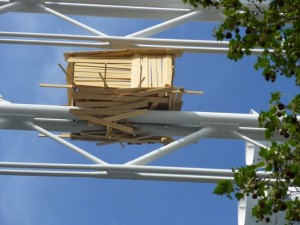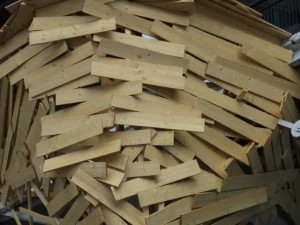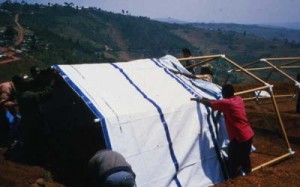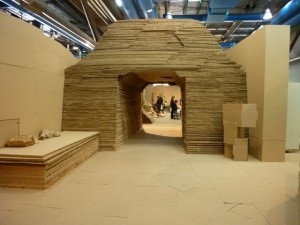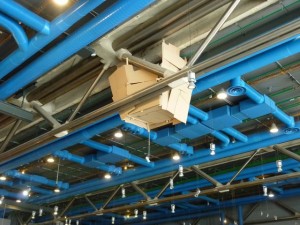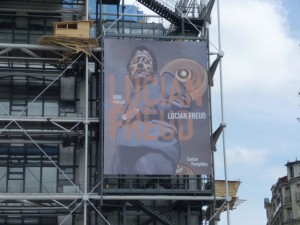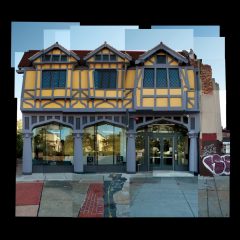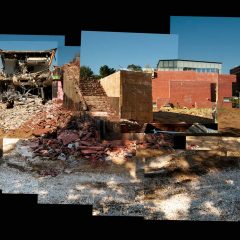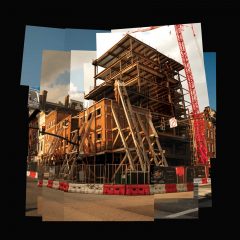The Centre Pompidou, located in the heart of Paris, was originally conceived as a temporary structure in 1977. Though it has become a permanent and thriving cultural hub the Pompidou’s original temporary identity remains intact as witnessed by the current installation of cardboard – based works by the Japanese artist Tadashi Kawamata on the centre’s facade.
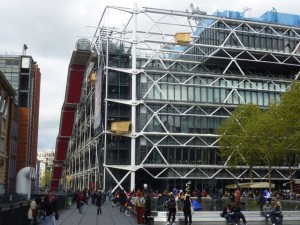 Assembled like bird’s nests and yet fully exposed and not fully anchored or integrated into the external beams of the centre on which they sit, Kawamata’s wooden cabin structures contrast greatly with their host glass and steel structure. Built of planks most of which seem to be non structural they evoke a gamut of sheltering possibilities from urban allotment shacks and shanty town homes to ersatz work site shelters and offices. They are eerily vacant and suggest a Matthew Barney Drawing Restraint Moment where art is being made in the most improbable places.
Assembled like bird’s nests and yet fully exposed and not fully anchored or integrated into the external beams of the centre on which they sit, Kawamata’s wooden cabin structures contrast greatly with their host glass and steel structure. Built of planks most of which seem to be non structural they evoke a gamut of sheltering possibilities from urban allotment shacks and shanty town homes to ersatz work site shelters and offices. They are eerily vacant and suggest a Matthew Barney Drawing Restraint Moment where art is being made in the most improbable places.
We aren’t allowed the pleasure of climbing up to and into them and thus relive the childhood experience of the tree house. Because they are unattainable these outposts become metaphor boxes akin to castles in the sky as seen in japanese animes. Perhaps there is a scale game going on here whereby Kawamata is suggesting that we somehow wouldn’t fit into these assemblies. Perhaps they are the magnified images of tiny things.We are left, then, to dream of climbing up into one thus inhabiting an inner city outpost, deliciously suspended above and beyond the masses.
The incongruity of these plank clouds dotting the Pompidou doesn’t suggest symbiosis but rather benign parasitism. The groups of boards recall a swarm of bees, a nomadic colony creating a “structure” by virtue of the way individuals converge to form a group. Weather, material deterioration, exhibition schedules and derogations will send this stuff on its way to regroup elsewhere.
This isn’t the first time that the Pompidou has housed a temporary structure. The Japanese architect Shigeru BAN used to have his cardboard offices on the roof. It was there that he designed his portion of the new Centre Pompidou Metz which is currently just a few days away from completion. Ban is well known for cardboard structures including the Nomad Museum and his paper emergency shelters for UNHCR. The paper shelters consisted of cardboard tubes covered in plastic. The tubes were cheap and easy to manufacture on site thus eliminating transportation costs.
Kawamata and Ban are cardboard soul mates but at opposite ends of the longevity spectrum. A sheet of this ubiquitous packaging material is almost fragile enough to do origami and yet when combined in layers and compressed can be used to build a museum. Kawamata takes his chances and opts for fragility while Ban must follow long term imperatives, including housing Kawamata creations.
Inside the museum Kawamata reverts to cardboard and has set up a children’ workshop in a cardboard niche within the museum. A monumental gateway to this workshop that seems to have been eroded by the sands of time lends historic weight to the corrugated paper. Sound is muffled. We learn that cardboard is highly transformable and the workshop reveals many of its different states whether it be a solid wall or the support for a series of folds. We slowly begin to see out of the cardboard box.
Elsewhere in the workshop space were learning stations consisting of metal closets complete the binders containing information sheets, a TV with a video and a fold out table. These are learning outposts for a country with neither computers nor internet.
The playfulness and delicateness of this mixture of corrugated paper works and woodworks is heartwarming even if a certain sad vacantness pervades. Cubic cardboard structures lodged in the pipework like lost balloons that escaped someone’s hands dot the Pompidou’s ceiling.Does the sadness come from ours and the artist’s knowledge that his work will disappear? Kawamata’s structures as compared to the Pompidou present us with degrees of the temporary and the cobbled as compared to the engineered. How long will it be before Kawamata’s boxes become debris?
Humans depend on the temporary for short term solutions but we crave the solid and the enduring. As witnessed by today’s museum-building race we are constantly creating permanence to house impermanence. One social advantage with temporary projects is that they give us time to either adopt or reject them. Perhaps the label “temporary” is a ploy to place new and potentially antagonistic buildings within old quarters. Happy to know that it will all go the locals forget about it and then, before long, no one can live without it.
In any case Kawamata will never derange for long if he deranges at all. Here at the Pompidou he searches to establish outposts in far and unexploitable places that are in sight and just out of arm’s length. He is interesting noise between information nodes, a gremlin dancing in and around the permanent collection pulling our gaze upwards and over, happily distracting us from the main feature.


